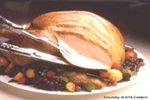“Tough, tasteless and dry.” Three words you don’t want to hear your family and guests use to describe the turkey at the center of the holiday dinner table. Yet, according to turkey industry experts, those words are often used to address the state-of-the-bird.
“The biggest complaint people have about turkey is that it’s tough and dry,” says Lynn Lauve, marketing manager of Honeysuckle White Turkeys, Springdale, Ark. “People want their holiday turkey to be moist and flavorful.”
Avoiding a parched bird doesn’t have to take hours of preparation, constant consideration or endless lamentation. All it takes is salt and water.
Brining
Simply soaking your turkey in a salt brine the night before the big day could very well save your holiday turkey from a dry and flavorless fate.
“Brining results in a turkey that is flavorful and juicy,” says Michele Anna Jordan, chef, syndicated food writer and author of the cookbook Salt and Pepper. “Salt’s natural ability to draw out a food’s true flavors and juices will ensure that your bird will retain its moisture during roasting.”
The Right Stuff
Brining requires a fresh turkey. The majority of frozen turkeys at the supermarket have been pre-basted with turkey broth, fats or flavorings. This is done to eliminate the chore of basting a turkey during the roasting process. A fresh turkey is just that: fresh and free of any ingredient except turkey. A fresh turkey lets you use any method you choose to boost the flavor and moisture content of the bird.
Salt comes in several forms. The right salt will enhance the natural flavor of a fresh turkey and help it remain juicy. One option is regular granulated table salt, which consists of small, hard cubes that dissolve slowly. Another option is kosher salt, which has crystals that are light and fluffy, much like snowflakes. Kosher dissolves easily, and if you use a kosher salt that does not contain the iodine often found in table salt, its taste is clean and pure.
“You can use basically brine with any salt you wish,” says Jordan, “but I recommend using a good kosher salt, like Diamond Crystal brand kosher. I like its unique flakes that dissolve quickly. It has no anticaking agents or additives — just pure salt. Diamond Crystal’s flakes taste fresh and light: perfect qualities for creating a good brine.”
The Simple Solution
For maximum flavor, brining a turkey should begin the evening before it is roasted. Use a large stockpot should have enough space to brine a bird.
The general “recipe” for brining is one cup of kosher salt to one gallon of cold water. Fill the stockpot with the cold water, add the kosher salt and stir until the salt has completely dissolved. Once dissolved, the salt and water mix will stay suspended.
Leave the turkey’s legs in the “lock” and remove the neck and giblets from the body and neck cavities. Next, place the turkey in the pot and cover it with a lid, towel or plastic wrap and place the pot in the refrigerator (if necessary, remove a shelf to accommodate the size of pot). There is no need to stir the solution or shift the turkey unless the brine doesn’t completely cover it. If that’s the case, turn the turkey every few hours to make sure each part is submerged at some point.
Roasting
When it’s time to roast the bird, remove it from the brining pot, pat it dry with paper towels, add stuffing and place in a shallow roasting pan with the breast side up. Average roasting temperature for a turkey is 325 degrees. Cooking time will depend on the bird’s size and whether or not it’s stuffed, but ranges from 13 to 25 minutes per pound. Check the turkey’s package recommendations for proper cooking time. When the bird is done roasting, test it with a meat thermometer to ensure it is fully cooked. The thermometer should register 185 degrees in the thighs and 170 degrees in the breast.
Unfortunately, that’s easier said than done. White meat cooks faster than dark meat so, chances are, when the dark, thigh meat finally reaches it’s optimal temperature of 185 degrees, the breast meat is also at least that hot, usually resulting in dry white meat. That’s why brining, which keeps the breast meat moist, is so important.
“Brining ensures the breast meat stays succulent while the dark meat cooks,” says Jordan. “The salt pulls out the turkey’s natural juices and the added water essentially steams the turkey breast.”
Added Touches
Although brining should prevent a dry bird, Jordan goes one step further to guarantee a tender turkey. “I soak a tea or flour-sack towel in melted butter and place it over the breast of the turkey while it roasts,” says Jordan. “I also take the bird out thirty minutes before its scheduled finish time. I tent the pan with tin foil and leave the turkey on the counter to let the juices settle.”
Brining is a simple solution for a stress-free holiday turkey.
The Author:
For Michele Ana Jordan’s brining recipe, to order Diamond Crystal kosher salt or additional information on salt, log on to www.cargillsalt.com. For brining and other turkey tips, log on to the National Turkey Federation’s Web site at www.eatturkey.com or Honeysuckle White Turkey’s Web site at www.honeysucklewhite.com

If you are on a reduced sodium diet I don’t think brining a turkey is a good idea.
I bought two Jenny-o turkey breasts. They weighed 5 lbs each. I roasted them at 325 degrees for 2 hours. The skin didn’t look cooked, but the inner temp was OVER 180 degrees, so I took them out. The meat was so juicy it looked wet, and it was chewy and tasteless. I’ve made turkeys for 40 + years and never had this happen before. What did I do wrong?